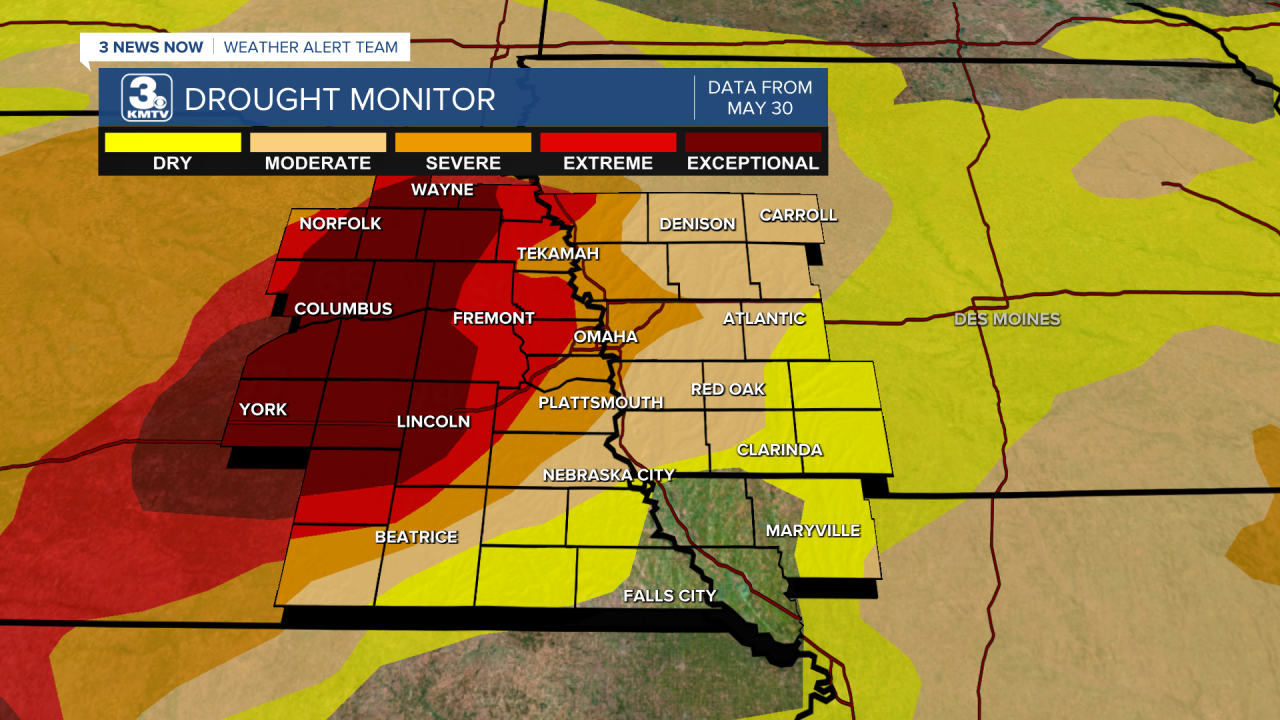The top weather story for the past year for Nebraska and Iowa has been the ongoing drought. These have been the worst drought conditions since 2012, and the latest drought update continues to show worsening conditions for much of eastern Nebraska into western Iowa. How much rain would it take the completely end the drought in 1 month? The season? The rest of the year? Find out below!

Let's start with the worsening drought situtation. This is the drought monitor from the beginning of May. Northeast Nebraska was the center of the drought, with the exceptional (5/5) drought from Columbus to Norfolk to West Point. Lincoln was in the extreme (4/5), and Omaha in the moderate (2/5) categories. Meanwhile, southeast NE, northwest MO, and southern IA were largely drought free.

The latest drought monitor a month later, which came out today, paints a much bleaker picture. After Omaha received the driest May on record, west of the I-680 corridor has been upgraded to the extreme (4/5) category with the rest of the metro in the severe (3/5) category. The exceptional drought now expands to include York, Seward, Wahoo, and Lincoln. While the drought creeps back into southeast NE, northwest MO, and southern IA.

Eastern NE and western IA was the exception to the rest of the state in terms of drought updates for May. At the beginning of the month, much of Nebraska was located in the level 3-4 categories. Meanwhile, drought was fairly absent over Iowa with the exception of the western side of the state.

Beneficial rainfall over western and central NE eliminated the level 4 category for much of the state, now sitting in a level 2-3 category. In Iowa, while the drought had not particularly expanded, dry conditions now encompass much of the state.
So, how much rainfall would our region need to see to completely break the drought? Remember, drought busting requires multiple rounds of beneficial rainfall to make a dent in it. You don't water a plant once and expect it to live much longer, you need repeated rounds of rain. These are the numbers:
To break the drought by the end of the month of June, eastern Nebraska would need to see between 12-15" of rainfall! On average, Omaha receives around 4.41" for the month, so we would need 350% as much rain than that to completely break the drought.
If we were to break the drought over the summer (Jun-Aug), we would need to see 18-21" of rainfall for the summer. Omaha recieves around 12" of rain during a typical summer, so we need 150% of our normal rainfall for the summer in order to break the drought.
By the end of the year, our area would need to see between 24-29" of rainfall by December 31st. Usually, Omaha recieves around 20" of rain from June 1 to December 31st. Meaning again we would need to see 150% of our yearly rainfall to break the drought.
What does this mean? It means that this drought is unlikely to go away anytime soon. We need to switch to a very wet pattern to see some of this break somewhat. It's doable, but we need to see some rain.


